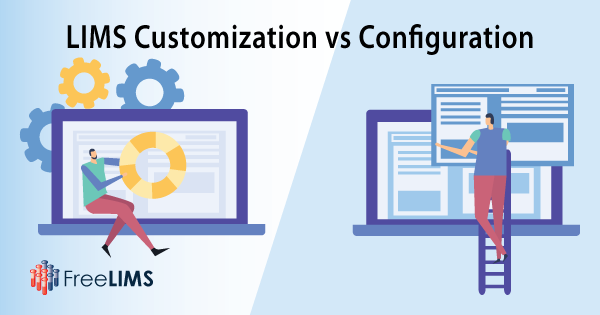Each laboratory is different from the other in terms of their requirements and workflows. A LIMS should be flexible to support the needs and workflows of laboratories, which is usually termed as LIMS customization or configuration. Both these terminologies are often used interchangeably. However, when it comes to using them with respect to a LIMS, both hold different meanings. In this blog, we delineate the distinctions between LIMS configuration vs. customization to provide a comprehensive understanding of these essential concepts.
Customization refers to changes in the code with the help of programmers, which includes developing new functionalities or enhancing existing ones. Configuration, on the other hand, refers to the use of inbuilt tools in a LIMS system to meet the requirements of individual laboratories without any changes in the underlying code. Some examples of LIMS configuration are defining user roles, configuring formula expressions, adding data elements such as sample and test types, defining input forms and reporting templates, building workflows, and triggering events. These events may involve actions such as sending automatic alerts to laboratory managers when the quantity of laboratory inventory falls below a certain level, flagging abnormal experimental values, or indicating when an instrument needs calibration.
LIMS Customization
Customization is usually carried out by changing the standard code or writing a new code right from scratch. Sometimes, the source code in many LIMS software is available in a compiled format and hence cannot be customized. However, in some LIMS, the environment is such that the code can be written to meet the specific requirements of the customer.
LIMS Configuration
The configuration is done by bringing together functional elements of a LIMS to mirror specific laboratory workflows and meet evolving requirements. Truly configurable, without a custom code written, means that a LIMS can be adapted quickly to meet user requirements in terms of workflows, reporting templates, data elements, terminology, and more.
Difference Between LIMS Customization & LIMS Configuration
When laboratories contemplate strategies to enhance the efficiency of their systems, a pivotal dilemma often arises: the decision between system configuration and customization. This choice carries substantial implications, encompassing both initial financial outlays and the system’s long-term adaptability.
Firstly, there’s the matter of the initial cost. Customization necessitates an upfront investment involving the engagement of proficient programmers to implement essential alterations. This expenditure can be substantial but promises tailor-made solutions.
Yet, it’s essential to acknowledge the risk of complexity. Customized solutions may initially appear enticing, but they have the potential to obfuscate underlying complexities. This poses certain risks, as such systems might not fully align with the evolving needs of your organization, leading to functional gaps.
Moreover, maintenance and upgrades are inextricably linked to custom code. The longevity of customized systems is contingent on the pace of system upgrades provided by the supplier. This may demand additional work, potentially incurring extra costs and the hazard of the code becoming obsolete over time.
Lastly, the ever-changing nature of user requirements underscores the necessity for flexibility. As the needs of users evolve, so must the code that supports the system. This ongoing process can carry financial implications, necessitating further code modifications and possibly re-validation of the system’s functionality. Thus, striking a balance between initial investment, adaptability, and long-term sustainability is paramount when laboratories weigh the choice between system configuration and customization.
In summary, customization of a LIMS requires testing and validating code to ensure that it does not have any adverse consequences on the rest of the standard code. Customization requires considerable time and costs to disassemble, change, and reassemble the LIMS software. Furthermore, a lot of time is consumed in validating and testing the resulting customization. Despite customization, sometimes, a LIMS may not meet the needs of laboratory managers, and hence, it may require further modifications or developing functionality from scratch. Although it appears that modifying the standard code according to specific requirements is better, it becomes an issue when a feature upgrade or a completely new version is provided by the supplier. Additionally, the laboratory requirements keep changing from time to time, which may require continuous rework on the code. Furthermore, to make revisions on the code, a lab is dependent on the vendor and has to eventually give in to all the technical specifications and commercials laid down by them. This can lead to a situation in which the overall project turns out to be much more expensive than the product itself.
Choosing a truly configurable LIMS ensures the long-term sustainability of laboratories. It is observed that a few LIMS available in the market still lack a secure and sustainable configuration strategy. They also do not have the ability to configure and hence put the integrity of the entire system at risk. LIMS implementations vary from small labs having simpler requirements to large labs having complex requirements. Since a LIMS helps in managing different types of laboratories, such as clinical, research, and analytical testing laboratories, they must be easily configurable to suit various requirements and save a lab from costly customization projects.
Conclusion
In conclusion, when it comes to choosing between LIMS customization and configuration, it’s important to weigh the specific needs of your laboratory against the potential costs and complexities. While customizations offer tailored solutions to meet requirements of individual laboratories, they can lead to higher expenses and maintenance challenges. Heavily customized LIMS increase the cost and complexity, making it difficult to implement and maintain. On the contrary, with configuration, workflows, report formats, and data components can be swiftly adjusted by laboratory staff without the complexities of modifying the standard codebase. LIMS configurations are inexpensive to implement and lesser complex to maintain.
If you are looking for a LIMS system that is flexible and easy to configure, you can sign up for FreeLIMS to seamlessly manage data and mirror your laboratory workflows.


